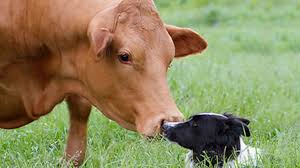Neosporosis is one of the most common causes of bovine abortion, especially in intensively farmed cows. Neospora caninum is a microscopic protozoan parasite with worldwide distribution. Many domestic (eg, dogs, cattle, sheep, goats, water buffalo, horses, chickens) and wild and captive animals (eg, deer, rhinoceros, rodents, rabbits, coyotes, wolves, foxes) can be infected. Neosporosis abortion also occurs in sheep, goats, water buffalo, and camelids, although they may be less susceptible than cattle. It is World worldwide disease of dogs that can cause neurologic signs and muscle inflammation also called reproductive failure.
ETIOLOGY of Neosporosis:
It is caused by the protozoan parasite Neospora caninum. Earlier misclassified as toxoplasma Gondi. First recognized in dogs in 1984 in Norway and defined as a new genus and species Neospora caninum.
Host Range for Neosporosis:
- Major domestic livestock species
- Companion animals
- Few wild animals
- Marine animals
Pathogenesis of Neosporosis:
- The organism has a predilection for fetal chorionic epithelium and fetal placental
- blood vessels producing fetal vasculitis, inflammation, and degeneration of chorioallantois, and
- widespread necrosis in the placenta.
- Tachyzoites penetrate the host cell and are located in the parasitophorous vacuole.
- They can be found in macrophages, monocytes, vascular endothelial cells, fibroblasts, hepatocytes, renal tubular cells, and infected animals’ brains.
- Cell death by the active multiplication of tachyzoites.

Neosporosis Transmission:
Cows contact this parasite in One or two ways
- Horizontally by consuming feed and water contaminated with eggs (oocysts) from infected dogs and
- other canids
- vertical transmission from the cow to the fetus during pregnancy.
- For more knowledge click here.

Neosporosis Clinical Signs in Cattle and Dogs:
In dogs:-
- Signs are more severe in young and immunocompromised.
- Weakness ( part, neck), incoordination, and difficulty in swallowing.
- Neuromuscular degeneration observed – hind limb paralysis.
- Adult dogs may develop skin lesions and pneumonia.
- Visit our YouTube channel for more details.
IN CATTLE:
- Abortion
- Abortion from 3 months gestation to term. Mostly 5-6 months.
- Fetuses may die in utero, be resorbed, mummified, autolyzed, stillborn, alive with clinical signs, or born clinically but normally infected.
- Hinds limbs and forelimbs or both may be flexed or hyperextend.
- Calf may have exophthalmia or asymmetrical appearance in eyes.
Neosporosis Prevention and Management:
Neosporosis in Dogs:
- No drugs or vaccines that prevent disease in dogs
- Avoid feeding raw meat
- Avoid access to aborted bovine fetal materials
- Cease breeding from infected dams – transplacental route
- Introduce serological monitoring programs in pups
Neosporosis Prevention in Cattle:
- No commercial vaccine presently available for neosporosis
- Quarantine and testing of replacement and purchased fetal
- Prevention of transmission from dogs and other potential definitive host
- Transfer of embryos from infected dams into uninfected recipients can prevent
- endogenous transplacental transmission of N. caninum.
- You can check more details here.
TREATMENT for Neosporosis:
- Clindamycin – 22 mg/kg bid for 60 days – drug of choice for muscle and skin involvement
- Trimethoprim- sulfa drugs – 15-30 mg/kg bid for 28 days – particularly when neurologic disease is present
- Additional supportive care
- Treatment is uneconomical in cattle – no chemotherapy for bovine neosporosis has shown to be safe and effective

